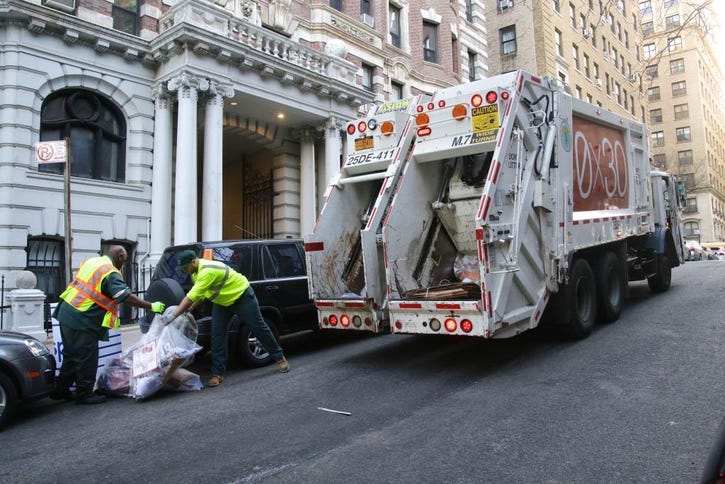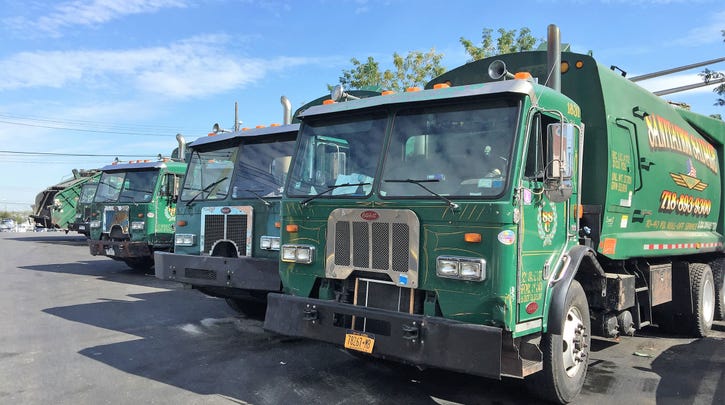Waste and recycling industry leaders are improving programs, offering more training and backing new regulations in an effort to improve safety.
It’s no secret that the job of a sanitation worker is one of the most dangerous professions in the U.S. It has been ranked in the top five deadliest jobs list for years now, but those working in the waste and recycling industry are constantly aiming to make the roles within the industry safer.
From improving programs, to providing more training, to utilizing more technology, to proposing and passing new regulation and legislation, industry leaders are working hard to ensure that workers return home safe to their families each day.
Two associations leading the industry’s safety efforts are the National Waste & Recycling Association (NWRA) and the Solid Waste Association of North America (SWANA). Both associations offer a range of training materials, such as Safety Monday emails, and support laws like the Slow Down to Get Around legislation, which requires motorists to slow down and safely move over when approaching certain vehicles on the roadway.
“Since I got brought on board earlier this year, I have been trying to bridge the gap between what we’re seeing on the ground and what policies are being introduced and set in place,” says Kirk Sander, vice president of safety and standards at NWRA. “As part of that, NWRA has joined the Our Roads, Our Safety coalition, which allows us to help make commercial vehicle safety a priority."
As part of the Our Roads, Our Safety coalition, NWRA is focused on ramping up the conversation around distracted driving, which is a danger to workers and civilians alike.
“Many people don’t realize that our trucks stop every 27 seconds or so to pick up trash on residential routes. That is much different than other trucks out on the road, so it’s important for all drivers and pedestrians to be on the lookout for our vehicles,” states Sander. “Some of our members have shared videos captured by camera technology that show distracted drivers hitting a worker or garbage truck. These distracted drivers have caused some gruesome incidents, therefore educating everyone on the dangers of distracted driving is important.”

Don’t Drive Distracted
Driving while texting is a national epidemic, according to David Biderman, executive director and CEO of SWANA. And while it endangers other drivers on the road, it also endangers pedestrians and bikers who are in crosswalks and bike lanes.
“I see it every day on my way to work, and I can only imagine what it looks like from the cab of a garbage truck,” comments Biderman. “Putting aside the waste industry, it’s not a coincidence that the number of transportation-related fatalities have increased over the years after decades of decline as the use of smartphones increases.”
In an effort to decrease these transportation-related fatalities, SWANA is working closely with its members, lawmakers, municipalities and others to understand how the waste industry can play a bigger role in ensuring safety on the roadways.
One person who is stepping up to the plate to let the industry know how it can improve safety on the roadways is Michael Barasch, a transportation attorney for Barasch McGarry Salzman & Penson, who has represented hundreds of people harmed in train, bus and car crashes.
“The waste and recycling industry provides an important service of cleaning up our streets and handling our waste, but the problem is it appears to be so unregulated that drivers aren’t operating or maintaining vehicles in a safe way,” states Barasch. “Many are being forced to work extra hours due to a labor shortage, and many are striving to hit companies’ goals of completing as many pickups as possible on a route. These goals can cause employees to work too fast, putting themselves and others in danger.”

The industry, along with many others, has been facing a labor shortage for some time, but utilizing more technology and providing incentives like competitive salaries and bonuses are key to attracting and maintaining a talented workforce.
“Companies are taking steps to provide competitive salaries/bonuses and treat all workers with respect because in a country with a 3.6 percent unemployment rate, it’s becoming tougher to find qualified drivers and mechanics,” states Biderman. “Several companies and local governments are looking to people coming out of the military because they are used to being around heavy equipment, and they have discipline from being in the military. I think it is a fertile field of future industry employees.”
Companies are also integrating more technology into their operations to alleviate some of the workload for employees and to free up some employees to do other tasks. For example, some companies are using more automated trucks on routes, says Sander. This often means only one driver is needed on the route opposed to one driver and one or two helpers.
“Companies are making the labor pool bigger by making these operational changes and relying on technology for automatic pickup of bins and other tasks,” comments Sander. “Technology provides an opportunity for workers to remain in the truck, where they are the safest.”
While the industry is making some changes to work though this labor shortage, Barasch points out there are some drivers who are not licensed to operate commercial vehicles out on the roadways. He stresses that these drivers, as well as some licensed drivers, often receive violations over and over again before proper action is taken, if it’s taken at all.

Bronx, N.Y.-based Sanitation Salvage, which is now closed, is one example. In November 2017, Mouctar Diallo, a 21-year-old immigrant who had been working for Sanitation Salvage for more than a year, was run over by a fellow employee. The true nature of his death was covered up, and police were told Diallo was unknown to the company. And months later in April 2018, that same driver hit and killed 72-year-old Leon Clarke, a resident of the Bronx’s John Adams Houses, as he was crossing the street with a cane.
These fatal accidents sparked the attention of labor unions, environmentalists and community groups, which expressed their concerns and pushed for the hauler’s license to be suspended. These concerns, along with information on off-the-book employees, fatal accidents, unsafe conditions and more released by nonprofit ProPublica and radio network Voice of America and a further investigation conducted by the BIC, led the BIC to suspend Sanitation Salvage’s license in August.
The BIC’s investigation found a number of crashes at the company and routine violation of basic traffic safety laws. According to the commission, in the past three years, Sanitation Salvage has had 58 crashes, which resulted in two fatalities and 11 injuries. Four of the company’s drivers had at least four crashes each.
The commission also found that a majority of Sanitation Salvage drivers were driving in excess of the 14-hour daily legal limit for commercial truck drivers. A majority were also in violation of the 70-hour weekly limit. The BIC investigation also discovered Sanitation Salvage trucks being driven by workers who lacked proper licenses. Half of the company’s trucks have failed roadside inspections with maintenance violations so severe that the trucks were ordered off the road.
BIC also revealed previously unreported crashes, including a crash from May 7, 2018, when a Sanitation Salvage truck ran a red light and hit a motorcyclist in the Bronx.
At the time of its suspension, Sanitation Salvage was the largest carter in the Bronx and one of the largest in the city. And just days after the suspension, Sanitation Salvage fought back with a lawsuit against New York City Mayor Bill de Blasio's administration, arguing that it was not given the chance to defend itself before the BIC suspended its license.
After about a month, the BIC made the decision to lift the suspension on Sanitation Salvage’s license, causing backlash once again from labor unions, environmentalists and community groups. This ongoing controversy around Sanitation Salvage’s operations finally led the hauler to throw in the towel last month.
To avoid incidents like this in the future, Barasch advises the City of New York to provide mandatory safety driving training to all commercial vehicle drivers and to ensure that all trucks operating on the roadways are safe to do so.
“In a way, it’s going to cost a little more upfront because the city will want the industry to pay for the training and maintenance and safety checks, but it will save the industry money in the long run because it will reduce the number of injuries and accidents,” says Barasch. “By reducing the number of injuries and accidents, insurance premiums will come down, people like me will go out of business and the public and industry will be safer.”
The City of New York Department of Sanitation has been taking steps it feels will improve safety in the industry, such as its new franchise system that will roll out in coming years. And while some support the franchise system, others oppose it, stating it could potentially provide more safety problems.

4. Commercial Franchise Zones Explained
“I understand the motive for launching such a system, but it could have a negative effect by forcing fewer trucks to do more pickups and asking drivers to work even more hours,” comments Barasch. “I don’t think reducing the number of players in this business is going to help; enforcing the rules and allowing only safe trucks and competent drivers on the roadways will.”
In addition to enforcing the rules and making sure everyone is safe while operating large vehicles on the roadways, SWANA is working on connecting with more small and midsized haulers that often aren’t members of associations.
“I think the industry is doing a good job with providing training to those who want to be trained, but to me, one of the central problems is we aren’t reaching a very significant amount of the industry, which is small and midsized haulers,” says Biderman. “Most of these haulers aren’t members of associations, and they have a disproportionate number of the incidents involving collection where a worker gets killed. That needs to change.”
As we approach 2019, the industry is continuing its efforts to improve safety. SWANA, for example, is focusing on scaling up its hauler safety outreach program in both the U.S. and Canada, providing more tools and resources to reduce the frequency of incidents and injuries and reaching smaller haulers and local governments that aren’t part of an association or don’t have the resources to provide high-quality safety training to workers.
“We’re also working with NWRA and others to try and get more states to pass Slow Down to Get Around legislation and working to increase our communications to law enforcement in the states where those laws have already been enacted,” says Biderman.
NWRA is working to educate its members, communities and the public about best safety practices and what actions they can take to improve safety across the board. The association is also planning its Safety Symposium that will take place at WasteExpo 2019 in Las Vegas.
About the Author(s)
You May Also Like




